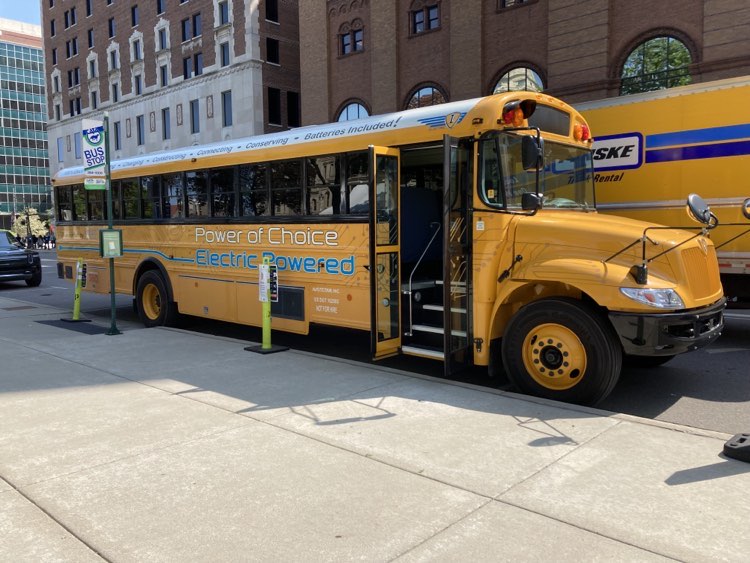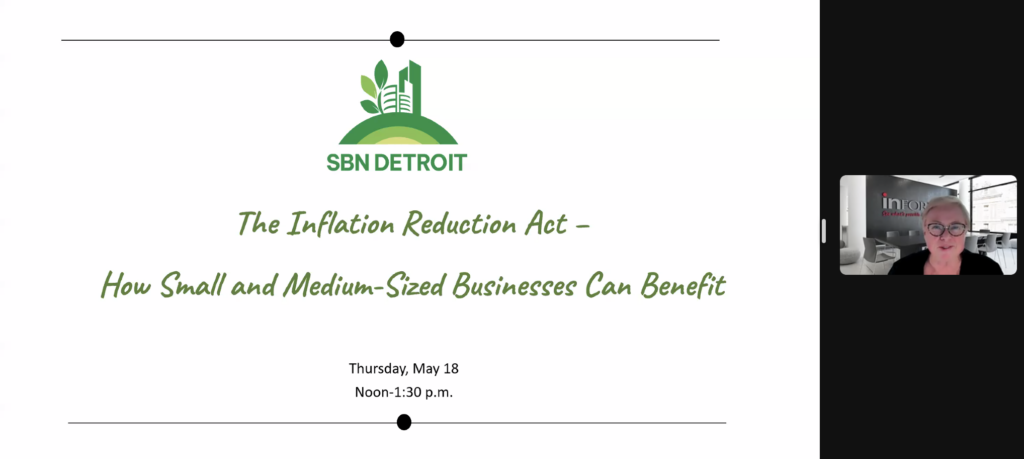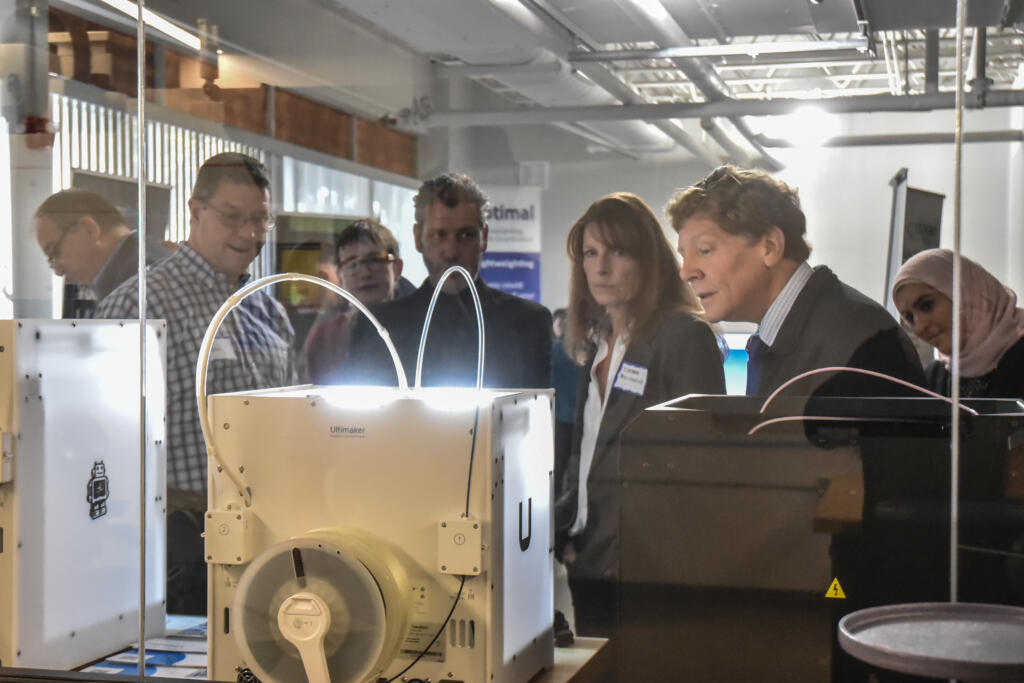A Look at EGLE’s Materials Waste Management Division

The Materials Management Division (MMD) of the Michigan Department of Environment, Great Lakes, and Energy (EGLE) oversees solid and hazardous waste programs, radioactive materials activities, a radon awareness program, recycling, and energy programs. We interviewed the director of the division, Elizabeth Browne, to get some insights. Q: How do you think energy efficiency, recycling, and pollution prevention are interconnected when it comes to fostering sustainability in Southeast Michigan? A: I have always felt you can’t have any without the others, and they are all key to having a sustainable system. Maybe it’s my biologist background. Recycling facilitates energy efficiency since it translates to diverting items from landfills. If you have a good system, you are reusing and recycling materials nearby, you save energy by not transporting material across state lines. When we look at energy efficiency, it works the same way. If we decrease the effort and resources put into heating, cooling, water usage, and transportation systems by becoming more efficient, we have more resources to allocate elsewhere. And isn’t that the very heart and definition of sustainability? Q: How do environmental justice and underrepresented communities factor into these efforts in Southeast Michigan? A: They factor in highly. There are federal funding requirements to help regulate this. The federal Justice 40 program deems that 40% of grant funds be used in underrepresented communities. Even before that, this was a focus for us. If you look at any of our requests for proposals, we pay special attention to projects coming from underrepresented communities – places where the community’s ability to be more sustainable has been stressed. We are always trying to level the playing field. Q: You work with state and federal partners, entrepreneurs, companies, organizations, and communities to reduce Michigan’s reliance on nonrenewable energy. Can you tell us more about this work? A: We work with federal partners in seeking every grant opportunity that we feel we have a nexus with. We work with companies and organizations through the Retired Engineers, Scientists, Technicians, Administrators, Researchers, and Teachers (RESTART) program. This is a group of retired professionals who work with entities to identify where they have energy issues or where renewable energy options may be a benefit. We do energy audits for houses of worship, schools, and municipal buildings. In many cases, these buildings are older and not efficient, so we offer ideas on how to improve efficiency and look at renewable options. This helps them save financial resources that they can then allocate elsewhere. We have received grant money through the Charge Up Michigan Program to install fast chargers in communities. Within this program, the cost of charger installation is divided amongst the location owner, the utility provider, and EGLE. This allows us to install more chargers, and it helps the utilities get closer to their energy efficiency goals and benefits the property owner or business. We have worked with communities to replace diesel- and gas-powered vehicles with electric ones, including Willow Run Airport and the City of Detroit. In Detroit, we replaced diesel-powered garbage trucks with EVs. We work heavily with NextCycle and the Centropolis Accelerator program at Lawrence Technological University. These are both programs to support businesses in their early stages. NextCycle is geared toward recycling activities, and the Centropolis Accelerator focuses on clean technology and the circular economy. Q: What are your biggest challenges in materials management? A: The thing that keeps me up at night is navigating grant programs. There is this huge influx of federal money, but there are a lot of checks and balances, and trying to manage the funding appropriately is a challenge. There is a lot of hurry-up-and-wait involved. We have a phenomenal team, and I don’t want to break their backs as they work to move the money out to recipients. Q: What are your highest priorities? A: Moving as much of the funding to those who need it and doing it in a way that is equitable and fair and hits the highest needs. Sometimes we make decisions that aren’t flashy, but the impact they have on that community is significant. A small community getting a few solar panels to help power their community building so the kids have someplace to go after school is a good example. We try to disburse the money in a way that supports as many communities and people as possible. Q: What does the future look like? A: I think it keeps getting brighter. The Michigan Legislature recently passed an eight-bill package that updates solid waste laws and will ensure we have sufficient landfill capacity. We just held our Virtual Michigan Materials Management Conference and had almost 600 people from 11 states represented. Getting EV chargers out across the state and seeing more and more interest in communities in terms of electrification is good progress. There is so much potential for economic growth in the energy and recycling fields. It’s astronomical. This excites me. Every day, I see people and companies that are looking for support and direction on becoming more sustainable. More and more companies understand the need to be sustainable because the public is demanding it, and it’s also for their own good. I encourage everyone to reach out to us. People interested in any EGLE grant programs can go to Michigan.gov\EGLE and search for “grants and financing.” For more information about all things Materials Management Division, our web pages can be found at Michigan.gov/EGLE/about/organization/materials-management. Be sure to subscribe to our newsletter for regular updates on sustainable business practices in and around Detroit.
The Inflation Reduction Act – How Small and Medium-Sized Businesses Can Benefit

The Inflation Reduction Act of 2022 includes $500 billion in new spending and tax breaks targeted toward climate change, clean energy, training, and workforce development, the development of clean infrastructure, and more. It puts the U.S. on a path to 40% emissions reduction by 2030 with these desired impacts: Lower energy costs Increased energy security Investments in decarbonizing all sectors Focused investments in disadvantaged communities Support for resilient rural communities Additionally, the legislation act offers businesses and entrepreneurs unprecedented opportunities but identifying these opportunities and navigating how to capitalize on them can be daunting. To help small- and medium-sized businesses understand the act, SBN Detroit held a virtual event on May 18 featuring Joel Howrani Heeres, director, Public Sector Consultants; Jerry Davis, professor, Ross School of Business; Dan Radomski, executive director, Centrepolis Accelerator at Lawrence Tech University, and Kimberly Hill Knott, president and CEO, Future Insight Consulting. Each speaker presented according to their areas of expertise, followed by a Q & A. We’ve shared some of the speakers’ points below. You can view the full event here. A significant portion of IRA rebates goes to homeowners, creating an opportunity for contractors to provide energy audits, electrification upgrades, and more. The funds allow for roughly 5,000 houses to take advantage of rebates. – Howrani There are five components involved in creating an enterprise – capital, labor, organization, supply, and distribution. The IRA creates opportunities within each of these components. – Davis When it comes to cleantech funding, it’s important to understand what stage of development you are in and how that applies to different funding opportunities. Generally, funding comes in when technologies are mature and ready for deployment. But there are different opportunities within the different stages. – Radomski As we transition to the Infrastructure Investment and Jobs Act (IIJA) there will be more investments in infrastructure, and the money will flow through state agencies and departments. – Radomski The key to being e successful with IRA funding is collaboration. Addressing climate change is multifaceted. For example, residential electrification dollars are coming. but many houses are not necessarily ready to replace fossil fuel sources with electricity. So, there is an opportunity to partner with community action agencies that manage funds for home repair to get homeowners ready. For example, the community action agency essentially does intake and prep, and a private contractor does the electrification work to use the rebates. – Howrani There are new opportunities up and down the supply chain from technicians to engineers to manufacturing. This is going to take an effort in workforce development by universities, community colleges, and manufacturers themselves. We need education in all of these areas which will lead to jobs and wealth creation. – Radomski My students surveyed local small businesses regarding their priorities around green energy. The overwhelming response was reliability. For these businesses, extended power outages could be catastrophic. This presents an opportunity – how do we solve this? – Davis Understanding that the IRA is not easily interpreted, I had my students translate parts of it into easy-to-understand How to Guides and also sample business models which can be found at Greenbiztransition.com View the full presentation and Q&A here. Be sure to subscribe to our newsletter for regular updates on sustainable business practices in and around Detroit.
The Centrepolis Accelerator – Working to Grow Manufacturing and Bring Sustainable Opportunities to Michigan

On the campus of Lawrence Technological University, the Centrepolis Accelerator is focused on the growth of Southeast Michigan’s small manufacturers and hardware entrepreneurs, largely in the areas of climatech, cleantech, and the circular economy. Centrepolis, a uniquely positioned nonprofit business facilitator, provides access to key resources, a collaborative community, product development, and manufacturing experts with an impetus to keep manufacturing in Michigan and thus bring Michigan manufacturers and companies new opportunities. Executive Director Dan Radomski previously held COO and chief strategy officer positions with Optimal Inc.– a Plymouth, Mich., based firm focused on product development, competitive benchmarking, and vehicle engineering. In a prior role as VP of industry and venture development at NextEnergy, Radomski led incubator services and market and technology analytic efforts to support the growth of early-stage and mature energy technology firms in areas such as wind, solar, advanced batteries, power electronics, vehicle electrification, smart grid, microgrid, natural gas, and energy efficiency. SBND spoke to him about the work Centrepolis is doing toward cleantech, climatech, and the circular economy as well as keeping development and manufacturing in Michigan. Q: What exactly is Centrepolis? A: The Centrepolis Accelerator is accelerating the growth of Southeast Michigan’s small manufacturers and hardware entrepreneurs with an emphasis on the circular economy. It’s the only incubator I’m aware of that offers in-house design, engineering, and prototype capabilities, plus access to funding, experts, customers, and strategic partnerships. If an inventor, start-up, small business, or manufacturer has an idea for a product, we are the place to come to get help in design, engineering, prototyping, testing, and prepping to manufacture. We work with many different individuals and entities. Some have engineering backgrounds and many do not. Designing out cost while ensuring durability and reliability in products are common challenges faced when bringing a new product to market. We harness the manufacturing expertise that’s so prevalent in Michigan and connect corporations and individuals to get more products developed and manufactured in Michigan. Q: How did Centrepolis come to be and what’s the impetus behind it? A: I grew up as a machinist working in my Dad’s machine shop. He and his friends made solid careers and good lives for their families as machinists. I’ve worked for small, midsized, and international product development firms and manufacturers throughout my career. Over the years I’ve seen a significant increase in outsourcing to China and started thinking about the future of my family and of other Michiganders. I felt like we needed a program to keep manufacturing in Southeast Michigan and help people who don’t have the engineering know-how. So, in 2017 we launched Centrepolis – the state’s only hardware accelerator program – with Lawrence Tech, the City of Southfield, and the Michigan Economic Development Corp. (MEDC). I also had some experience working with the Michigan Department of Environment, Great Lakes, and Energy(EGLE) so I took the idea to them. They said if the accelerator focused on cleantech hardware they would be interested in helping to fund it. I said we will focus not only on cleantech but also climatech and circular economy products, which came to be our C3 Accelerator program. Q: With whom do you work? A: This is another way we differ greatly from other incubator programs. Most incubators focus on helping start-ups only, but we offer services for all entrepreneurs whether they are an individual, a start-up, or established small businesses. Many would be surprised to know that 40% of our clients are established small businesses. We offer support on three levels essentially. First, we assist with customer discovery, competitive landscape research, and the securing of patents and trademarks. We also offer tactical support such as business strategy, and connections to customers, strategic partners, suppliers, and manufacturers. With some clients, we engage more deeply in the entire process, from investment to design to engineering to prototype to product launch. As we all know, there are solutions around sustainability globally, so we crowdsource and hunt down the best innovations in sustainable materials and recycling technologies and bring them into Michigan to partner with companies such as Whirlpool and Steelcase, among others. We have brought several companies with really interesting technologies focused on waste removal into Michigan to partner with manufacturers here. Q: What are some examples? A: Savormetrics is a great company in Canada. They are an award-winning AI-sensor company that provides Quality Assurance/Quality Controls systems to the food and agriculture industries to prevent food waste in food production, processing, and distribution. They have partnered with vertical farms and food processors here in Michigan and built solutions for vertical farms that increase yields by at least 30% and decrease operating costs by over 50%. Glacier is a very compelling recycling automation start-up in San Francisco that is developing a new robotic sorter for material recovery facilities that performs just as effectively as other robots, at a much lower cost and smaller footprint. We have facilitated funding for them through EGLE and partnerships with local material recovery facilities. Centrepolis also gained funding for local companies like Detect-It in Oak Park, which offers software that now helps to sort textiles such as end-of-life waste clothing and separate materials cotton from synthetic materials to improve recycling. Q: How are LTU students involved? A: We have five interns who are student workers. They help with business strategy as well as product design, engineering, and prototyping I can point to the Glacier recycling automation here. We are activating students now to help engineer and design a new end effector for robotic arms to help sort plastics for improved rates of recycling. Q: What does the future look like for Centrepolis? A: To continue getting more and more products made in Michigan. We currently have over three dozen products that have come out of Centrepolis that are completely made in Michigan. I’m also very proud of the fact that 366 of our clients now provide contracts with Michigan suppliers equating to over $24 million in business to the local supply chain. That’s an amazing amount of business and illustrates the economic multiplier of


